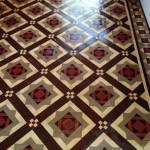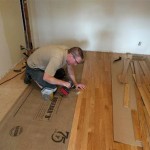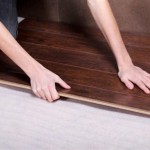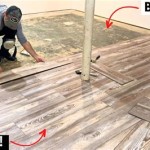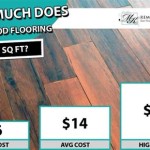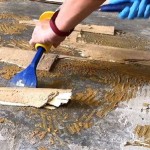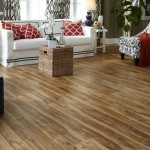Problems With Loose Lay Vinyl Flooring: A Comprehensive Overview
Loose lay vinyl flooring has gained popularity as a convenient and often cost-effective alternative to traditional glued-down or click-lock vinyl flooring. It is marketed for its ease of installation, requiring minimal adhesive and often no underlayment, making it an attractive option for DIY enthusiasts and those seeking a quick flooring update. However, despite its advantages, loose lay vinyl is not without its drawbacks. Understanding these potential problems is crucial before opting for this flooring type.
Loose lay vinyl flooring relies primarily on its weight and high-friction backing to stay in place. The planks or tiles are designed to grip the subfloor to prevent movement. While this feature simplifies installation, it also makes the floor susceptible to various issues that can compromise its performance and appearance over time.
Insufficient Adhesion and Movement
One of the most common problems associated with loose lay vinyl flooring is insufficient adhesion, leading to movement of the planks or tiles. While the high-friction backing is intended to provide a secure grip, it is not always sufficient, especially in areas with high foot traffic or significant temperature changes. This movement can manifest in several ways, including:
Shifting and Gapping: Over time, the edges of the vinyl planks or tiles may begin to shift, creating unsightly gaps between them. This is particularly noticeable in high-traffic areas or where furniture is frequently moved. The gaps can collect dirt and debris, making cleaning difficult and potentially damaging the edges of the flooring.
Curling and Lifting: In extreme cases, the edges of the vinyl planks or tiles may curl or lift off the subfloor altogether. This is often caused by temperature fluctuations, humidity changes, or excessive weight concentrated in one area. Curling and lifting can create tripping hazards and further compromise the integrity of the flooring.
Subfloor Imperfections: The success of loose lay vinyl flooring hinges on a perfectly smooth and level subfloor. Any imperfections, such as bumps, dips, or unevenness, will be magnified and can contribute to movement. Even slight imperfections can prevent the vinyl from making full contact with the subfloor, reducing its grip and increasing the risk of shifting.
Inadequate Preparation: Proper subfloor preparation is essential for any flooring installation, but it is particularly critical for loose lay vinyl. Thorough cleaning, leveling, and patching of any imperfections are necessary to ensure optimal adhesion. Failure to adequately prepare the subfloor can lead to premature failure of the flooring system.
Expansion and Contraction: Like all flooring materials, vinyl expands and contracts with changes in temperature and humidity. With loose lay vinyl, the risk of issues related to expansion and contraction is amplified. As the vinyl expands, it can buckle or warp, while contraction can create gaps. This is particularly problematic in large rooms or areas with significant temperature fluctuations.
Susceptibility to Damage and Indentations
Loose lay vinyl, while often durable, can be more susceptible to certain types of damage compared to glued-down or click-lock vinyl. This is primarily due to its reliance on weight and friction rather than a strong adhesive bond.
Indentations from Heavy Furniture: Heavy furniture can create permanent indentations in loose lay vinyl. Unlike glued-down vinyl, which is supported by a strong adhesive, loose lay vinyl is more likely to compress under the weight of heavy objects. This is particularly noticeable with furniture that has small, hard legs or feet. Over time, these indentations can become permanent and detract from the appearance of the floor.
Tears and Gouges: While most vinyl flooring is resistant to scratches and scuffs, loose lay vinyl is more vulnerable to tears and gouges, especially if the subfloor is not perfectly smooth. Sharp objects or heavy impacts can easily tear or puncture the vinyl, and these damages are often difficult to repair seamlessly. The lack of a strong adhesive bond means that the damaged area is less likely to remain stable, potentially leading to further damage.
Damage from Spills: While vinyl is generally water-resistant, prolonged exposure to spills can damage loose lay vinyl. If liquids seep between the planks or tiles and the subfloor, they can cause mold growth or damage the subfloor itself. The lack of a tight seal between the vinyl and the subfloor makes it easier for liquids to penetrate, increasing the risk of water damage.
Weakness at Seams: The seams between loose lay vinyl planks or tiles are inherently weaker than those in glued-down or click-lock installations. Without a strong adhesive bond, the seams are more susceptible to separation and damage. This is particularly true in areas with high foot traffic or where the floor is subjected to frequent cleaning.
UV Damage and Fading: Prolonged exposure to direct sunlight can cause the colors in loose lay vinyl to fade over time. While some vinyl products are UV-resistant, not all offer the same level of protection. Fading can be particularly noticeable in areas near windows or doors, leading to an uneven appearance.
Installation Challenges and Limitations
While loose lay vinyl is often marketed as easy to install, it can present certain challenges and limitations, especially for inexperienced DIYers. These challenges can impact the final result and the long-term performance of the flooring.
Subfloor Preparation is Critical: As mentioned earlier, proper subfloor preparation is paramount for a successful loose lay vinyl installation. The subfloor must be perfectly smooth, level, and free of any debris or moisture. This often requires significant time and effort, including patching imperfections, leveling uneven areas, and ensuring proper moisture control. Failure to adequately prepare the subfloor can negate the benefits of loose lay installation and lead to premature failure of the flooring.
Cutting and Fitting: While cutting vinyl planks or tiles is generally straightforward, achieving precise cuts and fits, especially around corners, doorways, and other obstacles, can be challenging. Inaccurate cuts can result in gaps or overlaps that detract from the overall appearance of the floor. Using the correct tools and techniques is essential for achieving a professional-looking finish.
Managing Expansion and Contraction: As with any floating floor, accounting for expansion and contraction is crucial. Leaving adequate expansion gaps around the perimeter of the room is necessary to allow the vinyl to move without buckling or warping. Failure to provide sufficient expansion space can lead to significant problems, particularly in large rooms or areas with fluctuating temperatures.
Suitability for Certain Areas: Loose lay vinyl is not suitable for all areas of the home. It is generally not recommended for areas with high moisture levels, such as bathrooms or laundry rooms, as the lack of a tight seal between the vinyl and the subfloor can allow water to seep in and cause damage. It is also not ideal for areas with very high foot traffic or heavy furniture, as the risk of shifting and indentations is increased.
Edge Treatments and Transitions: Proper edge treatments and transitions are essential for a finished and professional look. Thresholds, reducers, and other transition pieces are needed to seamlessly connect the loose lay vinyl to other flooring surfaces or to create a smooth transition between rooms. Choosing the right transition pieces and installing them correctly can be challenging, especially for novice installers.
Repair and Replacement: While individual loose lay vinyl planks or tiles can be replaced relatively easily, matching the existing flooring can be difficult, especially if the flooring has been exposed to sunlight or other environmental factors. Color variations and slight differences in texture can make the replacement noticeable. Furthermore, removing and replacing damaged planks or tiles can sometimes disrupt the surrounding flooring, requiring additional repairs.
In conclusion, while loose lay vinyl flooring offers certain advantages, understanding its potential problems is crucial. Careful consideration of the subfloor condition, the intended use of the space, and the installation challenges is essential to achieving a successful and long-lasting installation.
Loose Lay Vinyl Plank Flooring Pros Cons Floorings

What Is Loose Lay Vinyl Flooring How To Install Id

17 Problems With Loose Lay Vinyl Flooring Tidy Floor
Loose Lay Vinyl Plank Flooring Pros Cons Floorings

Problems With Loose Lay Vinyl Flooring Truth Revealed Tidy Floor

How To Repair Luxury Vinyl Plank Flooring The Palette Muse

Loose Lay Vinyl Plank Flooring Pros Cons Floorings

My Vinyl Plank Floor Review Two Years Later Cutesy Crafts

7 Big Problems With Luxury Vinyl Tile

17 Problems With Loose Lay Vinyl Flooring Tidy Floor
See Also
